
STEVEN J. ZALOGA, illustrated by JIM LAURIER
V-1 FLYING BOMB. 1942-52. HITLER'S INFAMOUS "DOODLEBUG"
Although FR155W had made repeated requests for changes and improvements to the Fi-103, the manufacturing plants were very reluctant to make any substantial alterations that might lower production. As a result, all of the missiles used in the summer 1944 campaign against London were the basic Fi-103A-1 version. Once production was well underway by the summer of 1944, a series of improvements and changes began. In June, a portion of the Fi-103s arrived with a hardened-steel cable-cutting blade along the front of the wing and the first 50 of these were launched on June 28th-29th. Provision was added for dispensing propaganda leaflets: a cardboard container about 1.5m (5ft) long could be carried in the tail and then released using a pyrotechnic device. FR155W also conducted its own experiments, dropping incendiary bombs and small anti-personnel bomblets from the missile.
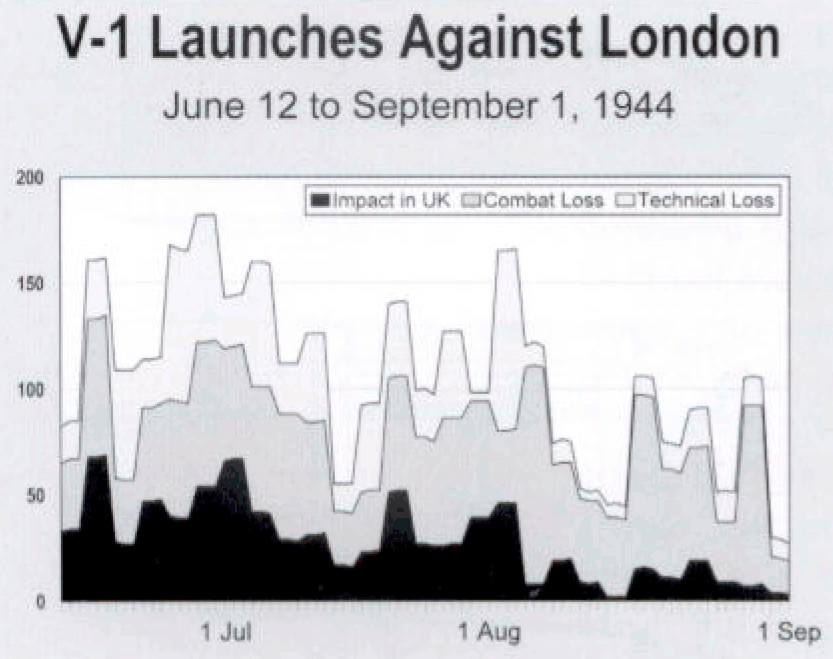
This chart shows the pace of missile launches by Flak Regiment 155 (W) against London In the initial phase of the campaign from June 12th to September 1st, 1944. The lower band shows the number of missiles which landed in England, the middle band shows the missiles brought down by air defense, and the upper band shows the missiles which crashed after launch or otherwise disappeared due to technical problems. Due to discrepancies in accounting between German and British records, the data are based on three-day averages which tends to level the extremes. (Author)
Due to shortages of the standard Amatol 39A+ explosive, substitutes such as 52A+ were used in some missiles. On June 25th, 1944. Hitler ordered thai 250 V-1 warheads per month be filled with Trialen, an enhanced blast explosive, and these were first used on July 18th, 1944. Other types of explosive such as Myrol were planned but not employed. By 1945 shortage of explosives led to the substitution of low-grade commercial Donarit explosive in many warheads.
During the 1944 summer campaign against London, about seven percent of the missiles were fitted with FuG-23 transmitters to help triangulate the location of the impacts. In later campaigns, the percentage fitted with this device increased substantially, and during the final actions of March 1945, more than half the missiles had this feature.
Due to steel shortages, a number of efforts were made to conserve material including the design of a wooden wing. The wooden wings had a slightly greater span than those of the original metal-wing A-1, and they reduced the wing weight by about 38 kg (83.77 lb). The first of the wooden-wing versions was the Fi-103B-1 which also substituted plywood for steel in some of the nose construction and had some other changes such as the location of the fuze pockets. The first wooden-wing Pi-103 missiles were launched in late February 1945. There was some change to the wooden wing late in the production run. A wooden-wing Fi-103 currently preserved at the Ordnance Museum at the US Army's Aberdeen Proving Ground shows that the internal framing of the wing was wood, but that a thin sheet-metal cover was added over the wood. The Fi-103B-2 was similar to the B-1 but substituted Trialen explosive and improved fuzing. The Fi-103C-1 used a lighter SC 800 aircraft fragmentation bomb inside the fuselage instead of the normal warhead to extend the range. The Fi-103D-1 was designed to carry chemical warfare agents; so far as is known there was no series production.
In the fall of 1944, intensive work was undertaken to extend the range of the Fi-103 so that it could be launched against London from sites in Holland. The initial version was the FH03E-1 which was fitted with a wooden wing, an enlarged fuel tank with a capacity of 810 liters (214 US gallons; 178 Imperial gal) instead of the usual 690 liters (182/152 gal), and a smaller plywood-encased warhead. The definitive long-range version was the FH03F-1 with 1,025 liters (271/225 gal) of fuel and the warhead reduced to 530 kg (1168.43 lb). A final type with the fuel tank increased to 1,180 liters (312/260 gal) was found at the Mittelwerke by Allied troops, hut does not appear to have entered serial production.
One of the lingering problems with the Fi-103 design was the inefficiency of its pulse-jet engine. Design studies for a jet-powered Fi-103 using the Porsche 109-005 turbojet engine were begun, but these did not progress very far before the war ended.

These original German plans show the warhead configurations of the main types of Fi-103. Externally, the Fi-103 variants can be distinguished by the location of the fuze pockets; otherwise, most of the warhead shapes were similar.
FR155W managed to extract about three-quarters of its troops from France, but all of the heavy launch equipment except that from III Abteilung was lost. The regiment was reorganized around two launch battalions and the other two were converted to flak units. New launch sites were scouted along the Rhine in Sauerland and northern Westerwald, but there was some anxiety about launching near heavily urbanized regions of Germany due to the large numbers of missile crashes. Since some launch sites had already been scouted in the Eifel forests along the Belgian frontier, these were the first sites to become active. The Eifel region was in range of the port of Antwerp, and the border area had only scattered German villages that were less likely to be hit by wayward missiles. By mid- October, one battery from III/FR155W was ready to begin launching missiles from the Eifel near Mayen. but examination of the 329 missiles in inventory found 226 to be defective, and repairs delayed the launches.

Starting in late June 1944, some of the V-1 missiles launched against London were fitted with a Kuto cable cutter to deal with the threat of barrage balloons. This illustration from the manual shows how the cutter was contained within the leading edge of the wing with the blade (A) attached by metal clips (B).
The first launches of Operation Donnerschlag ("Thunderclap") began from Germany at 07231ns on October 21st, 1944. Of the 410 missiles launched in late October, 55 were aimed at Brussels and the remainder at Antwerp. The improved autopilot permitted a new "oblique firing" (Winkelschuss) tactic. The launcher no longer had to be directly aimed at the target since the missile could make one course correction after launch to align itself to the target. The main advantage of this feature was that it made it difficult for the Allies to track the missile launch path back to the launch site. The disadvantage was that it caused a higher rate of crashes. By the end of the month, eight launch sites were operational in the Eifel, none of which was discovered by Allied aircraft due to the forest cover in the region. In spite of the best efforts of FR155W to avoid hitting German towns, V-1 and V-2 missiles often crashed after launch, and so the V-weapons were grimly dubbed the Eifelschreck ("Horror of the Eifel").
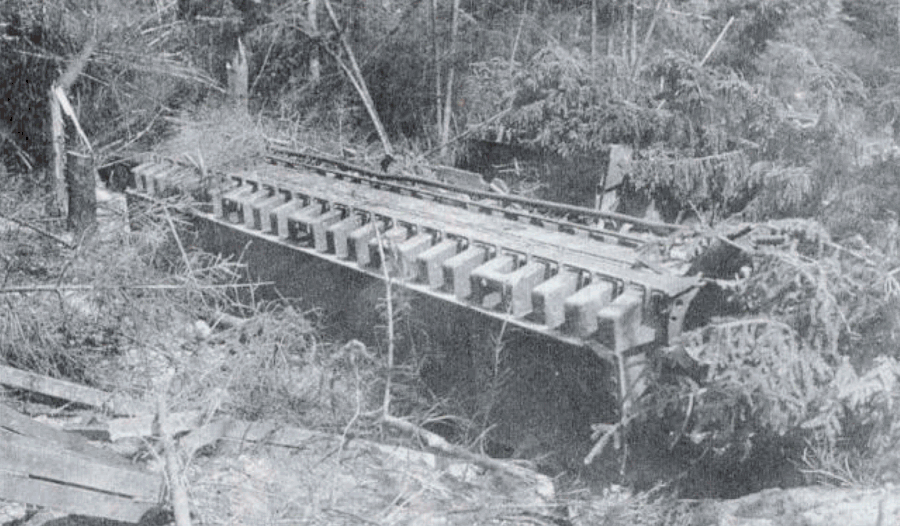
A collapsed Walter WR 2.3 launcher ramp discovered by US troops after the January 1945 Ardennes fighting pushed III/FR155W out of the Eifel region of northwestern Germany. These well-camouflaged launch sites in dense forests were shielded by winter overcast and ground fog, making them almost impossible for Allied aircraft to find. (MHI)
When Antwerp was captured by British forces in September, Field Marshal Montgomery recognized that the port would be a likely target for the Doodlebugs and asked Eisenhower to provide US anti-aircraft battalions to help defend the city. IX Air Defense Command originally deployed three gun battalions in mid-October, but as the pace of the German attacks increased, this grew to two AA brigades, four AA groups, seven gun battalions, two automatic weapons battalions, and a British searchlight regiment by early November.
The 65th Corps was renamed the 30th Army Corps on October 24th, 1944, for deception purposes. The original plan had been to use the corps headquarters to control both the V-1 and V-2 units, but when control over the V-2 missiles was usurped by the SS in the summer of 1944, the rationale for the corps disappeared. The corps was disbanded on November 16th, 1944, and the Luftwaffe combined FR155W and the partially organized FR255W into 5th Flak Division (W) with Colonel Walter of the corps staff as its commander.
On November 20th, 1944, III/FR155W began Operation Ludwig, launching missile attacks on Liege. This was prompted by continued requests from Army Group B since Liege was the center of US Army supply efforts for the fighting around Aachen. Anti-aircraft defense of Liege was begun on November 23rd, 1944, and proved far more difficult than at Antwerp due to the significant number of anti-aircraft rounds that fell into US Army troop concentrations nearby. To avoid this problem, the anti-aircraft units were moved as close to the front-line as possible.
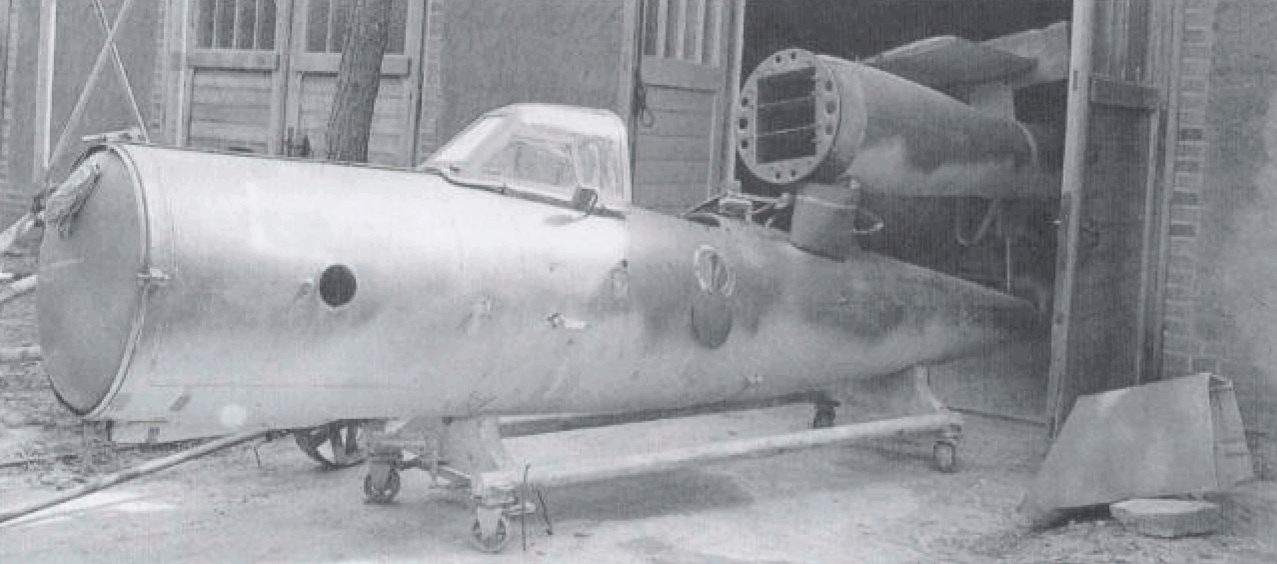
One of the curiosities discovered by the US 29th Infantry Division at the Luftwaffe's Karlwitz munitions depot near Dannenberg in April 1945 were these incomplete Fi-103Re.4 piloted missiles. The fairing that sat behind the cockpit canopy can be seen in the lower right. (NARA)
As the tempo of launches increased, FR155W began reconstituting a third battalion but the location of launch sites remained contentions. By December, 20 sites had been completed along the Rhine and eight launchers erected, but the continued high rates of crashes led to reluctance to launch from sites near German cites. Instead, the regiment decided to establish new sites in the Netherlands since, according to the regimental diary, "in Holland there is no need to worry about the civilian population in respect to premature crashes." Two battalions deployed to new sites around Deventer in the Netherlands, beginning their campaign against Antwerp on December 16th, while III/FR155W continued its attacks from the Eifel against Liege.
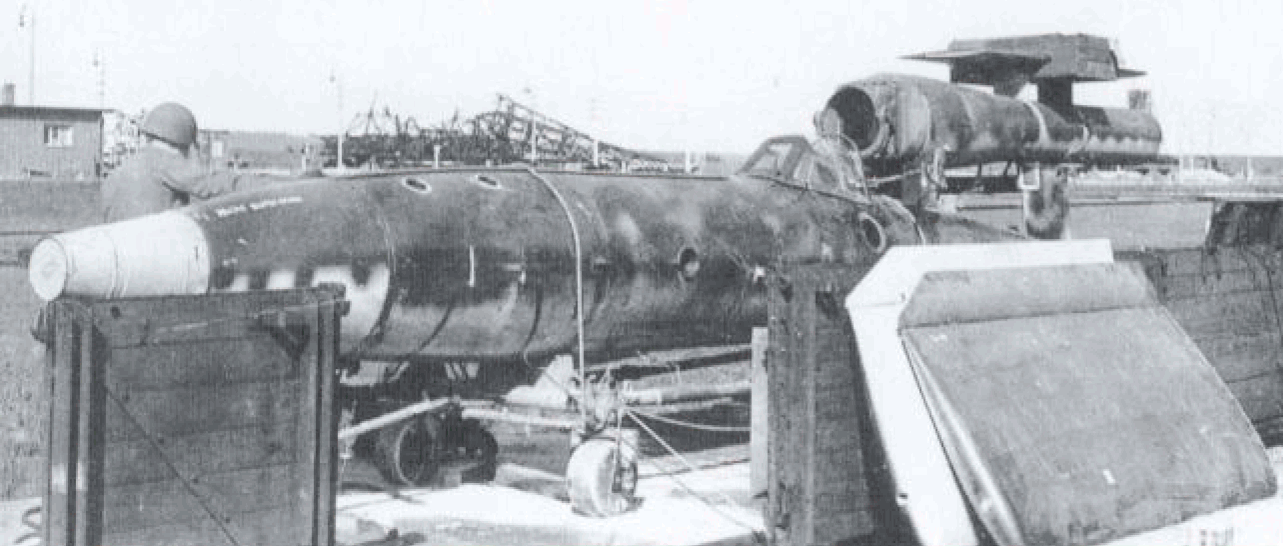
One of the few Fi-103Re.4 piloted missiles found with its intended warhead was this one, found near Rheinmetall's Hiller-sleben artillery proving ground on its TW-76 trolley. Its wings are stacked near the side of the rail car and show the ailerons that were added to this version of the missile. (USAOM-APG).
The start of V-1 attacks from Holland in December forced a reorganization of the Antwerp defenses to cover the northeastern approaches, but when the Germans launched their Ardennes offensive on December 16th, the US Army removed seven AA battalions from the defenses. Two British heavy AA regiments were added in their place. The anti-aircraft units assigned to Liege were in the thick of the Ardennes fighting, and were reassigned as improvised anti-tank units. Air defense of Liege was never reestablished.
The Dutch missile sites proved more vulnerable to Allied aircraft, in part due to the help of the Dutch resistance in identifying the sites. For example, on January 24ih, 1945, a flight of P-47 Thunderbolts caught a crew loading a missile which was destroyed on its launch rail. The next day an attack destroyed a missile storage area, blowing up 30 missiles and a considerable amount of fuel. The vulnerability of the sites led to a revival of the tactics used in France to move the sites periodically to avoid detection. The test of this tactic, called Operation Mülleimer ("Trashcan"), shifted batteries of II/FR155W to the Rotterdam area, and fired about 300 missiles in eight days starting on January 27th, 1945.
The failure of the German counter-offensive in the Ardennes in December 1944 threatened the Eifel launch bases and, on January 27th, III/FR155W was told to prepare for Operation Oktoberfest, a concentration of all three missile battalions in the Netherlands. Since not enough sites were ready there, one battery began launches from the abandoned launch sites around Cologne for a week starting on February 11th, 1945. The US Army restored the Antwerp defenses in late January, with the northeast corridor facing Holland receiving the most guns. The most important change was the decision to permit the use of proximity fuzes, which increased the kill rate. Nevertheless, air defense was difficult due to the close range of the launch sites, restrictions on die placement of guns due to Allied airfields and populated areas, and the low altitude of the missile approach. In total, FR155YV launched 8,696 Fi-103s against Antwerp, 3,141 against Liege and 151 against Brussels. Of the 8,696 launched against Antwerp, only 4,248 actually reached the Antwerp region, and of the 2,759 that entered the air defense zone around Antwerp, 1,766 were shot down and only 211 fell into the port area. The last Fi-103 struck Antwerp on March 27th, 1945, at 2245 hours. Casualties due to the Fi-103 totaled 3,736 civilians and 947 military killed, plus 8,166 civilians and 1,909 military . wounded. Of the total 14,758 casualties in Belgium, Antwerp bore the brunt of the share, 10,145 (8,333 civilian, 1,812 military), and Liege most of the remainder.
FI-103 ATTACKS ON BELGIAN CITIES
| Oct 44 | Nov 44 | Dec 44 | Jan 45 | Feb 45 | Mar 45 | Total | |
| Launched | 410 | 2,119 | 2,568 | 2,537 | 2,787 | 1,567 | 11,988 |
| Crashed | 48 | 292 | 363 | 429 | 374 | 225 | 1,731 |
FR155W was subjected to more reorganization in early 1945 due to the declining fortunes of the German war effort. Fuel was strictly rationed, and the supply of missiles was cut from 160 to 100 per day. At the end of January 1945, the 5th Flak Division was ordered to convert part of its force into an infantry regiment for dispatch to the Eastern Front, which cut the manpower in the launch units to a bare minimum. In mid-February, SS-Gen.Lt. Hns Kammler, SS special commissioner for missile operations, took over control of the division, and Walter was replaced by Wachtel as divisional commander after he refused to switch to the Waffen-SS.
The new extended range Fi-103E-1 missile became available in February 1945 and could reach London from launch sites in the Netherlands. A total of 21 launch sites was prepared for Operation Pappdeckel ("Pasteboard"). The attacks began on March 3rd, 1945, and 275 missiles were launched against London through March 29th, 1945. Of these, only about 160 flew any significant distance, 92 were downed by air defenses and only 13 reached London, the last on March 28th, 1945. With their launch sites about to be overrun in the Netherlands, the missile campaign came to an end. In total, the Doodlebug attacks had killed about 5,500 people and wounded 16,000 in England as well as causing substantial damage.
In retrospect, the V-1 was a far more effective weapon than the V-2 in terms of the much smaller cost of developing, manufacturing, and employing the missile. Paradoxically, the greater vulnerability of the V-1 to interception prompted the Allies to expend a great deal of effort to defend against it, both in the initial Crossbow bombing campaign, as well as the air defense efforts over London, Antwerp, and Liege. Nevertheless, the Allies could afford to divert resources to counter the V-1 while it is questionable that the German efforts on the V-weapons were commensurate to the results. The warheads of die V-weapons consumed the equivalent of half the total explosive consumption of the entire Wehrmacht in the critical months of July, August, and September 1944, and equal to the total explosives production of the fall of 1944. At a time when the fate of the Third Reich was in the balance, the V-weapons were wasting more than half of the available explosives to kill a thousand British and Belgian civilians a month. By the fall of 1944, the prodigal expenditures of the V-weapons program led to a shortage of explosives that was so acute that rock salt was being used as an extender in explosives for artillery ammunition, and severe limits had to be placed on the anti-aircraft defense of the Reich due to the ammunition shortage. While the V-1 attacks caused considerable misery for Londoners in the summer of 1944, the end of the war was in sight and the attacks had no profound impact on British morale. The attacks on Antwerp were even more severe, but only a couple of hundred V-1s actually landed within the port area, the ostensible objective of the campaign, and caused little significant damage. While the V-weapons may have satisfied Hitlers thirst for revenge, from a military perspective, they were utter folly.
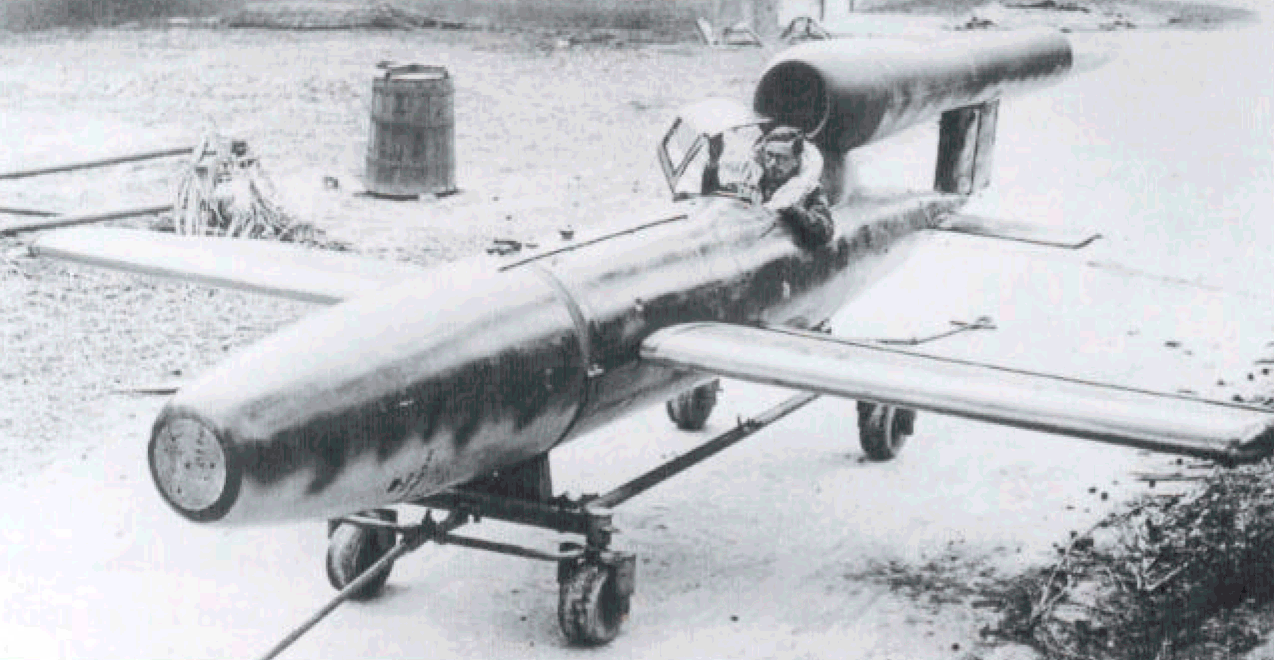
Although this is one of the best-known photos of a Reichenberg piloted missile, the configuration is a bit suspect. This particular example was assembled from parts found at the Karlwitz munitions depot near Dannenberg in May 1945 by a US Navy Technical Mission Europe team. It is by no means clear that this particular type of plywood warhead casing was actually intended for this version. The officer demonstrates how difficult it would have been for the volunteer pilot to have escaped from the missile while wearing the prescribed life vest. (NARA)
We have much more interesting information on this site.
Click MENU to check it out!
∎ cartalana.com© 2009-2025 ∎ mailto: cartalana@cartalana.com